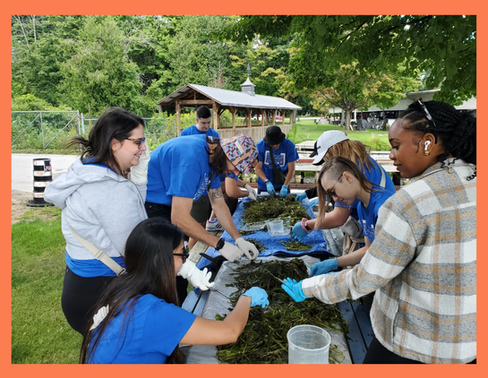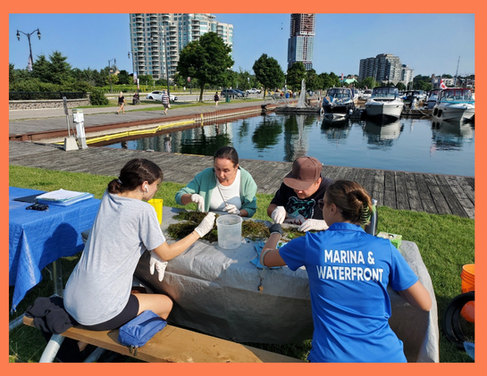Plastic Free July: Engaging Communities to End Plastic Pollution in the Great Lakes
- The Cleanup Team

- Jul 14
- 5 min read
By Isabella Hamilton, Great Lakes Plastic Cleanup Community Engagement Coordinator for Barrie-Innisfil
The Great Lakes Plastic Cleanup (GLPC) recognizes the Williams Treaties First Nations, including the Alderville First Nation, Chippewas of Beausoleil First Nation, Chippewas of Georgian Island First Nation, Chippewas of Rama First Nation, Curve Lake First Nation, Hiawatha First Nation, and the Mississaugas of Scugog Island First Nation, as well as the Huron Wendat and the Metis Nation of Ontario - Region 7 and acknowledges their historic connection and stewardship for the Lake Simcoe region.
What is Plastic Free July?
Plastic Free July began as an initiative of the Plastic Free Foundation in 2011, where Rebecca Prince-Ruiz and a small team in Western Australia came together to raise awareness about the growing impact of plastic pollution. The movement has grown to 170 different countries with millions of participants taking the pledge to go plastic free every July. It now stands as the largest plastic waste reduction campaign on the planet, enabling individuals to avoid over 12 million tonnes of waste and 1.7 million tonnes of plastic each year.
Despite the incredible efforts to reduce plastic waste, there is still a considerable amount that finds its way into our Great Lakes. In fact, it is estimated that over 10 million kilograms of plastic end up in the Great Lakes each year! To combat this, our team at the Great Lakes Plastic Cleanup is using innovative capture technologies to prevent and remove plastic in the Great Lakes, from the St. Lawrence River to Lake Superior and everywhere in between. Engaging communities as part of the solution is critical to our initiative. Since 2020, we’ve engaged close to 30K people at over 160 events across our network. Join us this Plastic Free July as we explore the impacts of plastic pollution and find ways to ensure it does not end up in our Great Lakes!
The Impact of Plastic Pollution on the Great Lakes
Since 2020, the Great Lakes Plastic Cleanup has reported the removal of over 244,000 pieces of debris and counting, averaging around 145 pieces each day! The most common types of plastic collected by our technologies include small hard fragments, foam pieces, and cigarette butts. If left in the environment, plastic pollution can harm ecosystems and marine organisms. There are approximately 3,500 species of plants and animals in the Great Lakes that are affected by plastic pollution, most commonly when it is consumed creating a blockage or piercing the digestive tract.
Many scientists and conservationists agree that the best way to reduce plastic pollution is to prevent it from entering our waterways at its source. By choosing to take part in Plastic Free July, you’re actively working towards creating a healthier and more sustainable planet for everyone.
Plastic pollution also has a strong economic impact on local communities; studies have pointed to the clean up of plastic pollution in the Great Lakes requiring up to $400 million annually, if we continue polluting at our current rate. While much of the attention surrounding plastic pollution is directed to oceans, freshwater systems are less diluted, meaning plastic is not typically flushed out by global currents. This highlights the importance of focusing research and cleanup efforts on waterbodies like the Great Lakes!
Pollution Probe’s CEO, Melissa De Young, noted that “we’ll never be able to remove all of the plastic that’s found in the environment, but what we can do is collect data on the types of plastic we’re finding and then we have a very good sense of what the sources might be and where that plastic might be coming from.”
The Great Lakes Plastic Cleanup: A Catalyst for Change
At the Great Lakes Plastic Cleanup, we understand the importance of community engagement, especially in the context of education, local action, and shared responsibility. Effective community engagement targets four main factors: shared understanding, local knowledge, increased ownership, and social cohesion. Plastic Free July began as a bottom-up movement, enabling consumers to rethink the way they use and dispose of plastic in their everyday lives. Similarly, the Great Lakes Plastic Cleanup works to educate and engage community members to become aware of the impact of plastic pollution in our lakes and to take tangible action against it. We’ve hosted over 270 community events, with many in the works for the upcoming summer months. Participating in our events is a great way to get involved this Plastic Free July. One way to get involved is by participating in our waste characterization events, which remove plastic from local waters using a variety of capture technologies:
Seabin: A trash skimmer for marinas and ports that pumps water through a filter to collect floating debris. It can also absorb petroleum-based oils and detergents using oil-absorbent pads.
LittaTrap: A lightweight, durable basket that fits inside storm drains, capturing 100% of plastic debris larger than 5 mm before it can enter waterways.
PixieDrone: A remote-controlled mobile skimmer that collects up to 160 litres of floating waste. It can operate for up to 6 hours on a single charge.
BeBot: An electric beach-cleaning robot that sifts sand, removes plastic waste, and levels surfaces without damaging the environment. It covers up to 3,000 m² per session and runs for 3 hours per charge.
Gutter Bin: A stormwater filtration system that prevents trash, microplastics, sediment, oils, greases, and heavy metals from entering urban waterways. It can be customized with functional art designs to build awareness for watershed protection and restoration.

Stay updated by following us on social media and Eventbrite, where we post upcoming events and hands-on opportunities with these innovative tools.
Find a Plastic Free July event near you: https://www.plasticfreejuly.org/get-involved/find-events-near-you/
Small Changes, Big Impact: How People Have Participated in Plastic Free July
What does participating in Plastic Free July look like? There are actionable steps you can take to reduce or remove plastic from your everyday life. For example, the healthcare industry relies heavily on single-use plastics. The South Metropolitan Health Services of Western Australia noticed this issue and chose to focus on making changes to their use of plastic-backed bed pads, which have a high turnover rate. Around 75 million underpads are discarded worldwide each year. Staff adopted a new approach to the use of these bed pads, by asking whether they could refuse (not use one at all), reduce (use less), reuse (clean their packaging), or swap (use an alternative product). One hospital set a 50% reduction goal, and within three months, had already reduced their usage by 35%.
Plastic is deeply woven into our lives, often serving necessary purposes, but alternatives do exist. Take Lucie’s story: She began by addressing “the top four we can’t ignore”: plastic bags, water bottles, takeaway coffee cups, and plastic straws. As a result, she halved the contents of her recycling bin and inspired those around her. “Although we’re not totally plastic free, we’ve significantly reduced the amount of plastic in our lives,” Lucie shared. “I focus on the things I know I can do and go from there.”
You don’t have to lead a hospital initiative to make a difference. Whether it’s using reusable containers, properly sorting waste, or learning about plastic pollution, every small step contributes to the larger goal of a cleaner, healthier environment.


Action starts with you! Plastic Free July is a great starting point, but we hope that the actions you take will last beyond the month. Be sure to follow along with the Great Lakes Plastic Cleanup’s social media and Eventbrite to stay up to date with events, and to learn how you can get involved!

Isabella is a recent Life Sciences graduate from Queen’s University and an incoming Master’s student in Biotechnology at McGill University. She is passionate about the intersection of science, innovation, and sustainability, with a focus on reducing plastic pollution, advancing sustainable materials, and addressing textile waste through circular economy models. Motivated by the environmental impacts of our current consumption systems, Isabella has pursued research and projects centred on ecological solutions. She looks forward to deepening her expertise and contributing to scalable, biotech-driven innovations that promote long-term environmental resilience.







Comments